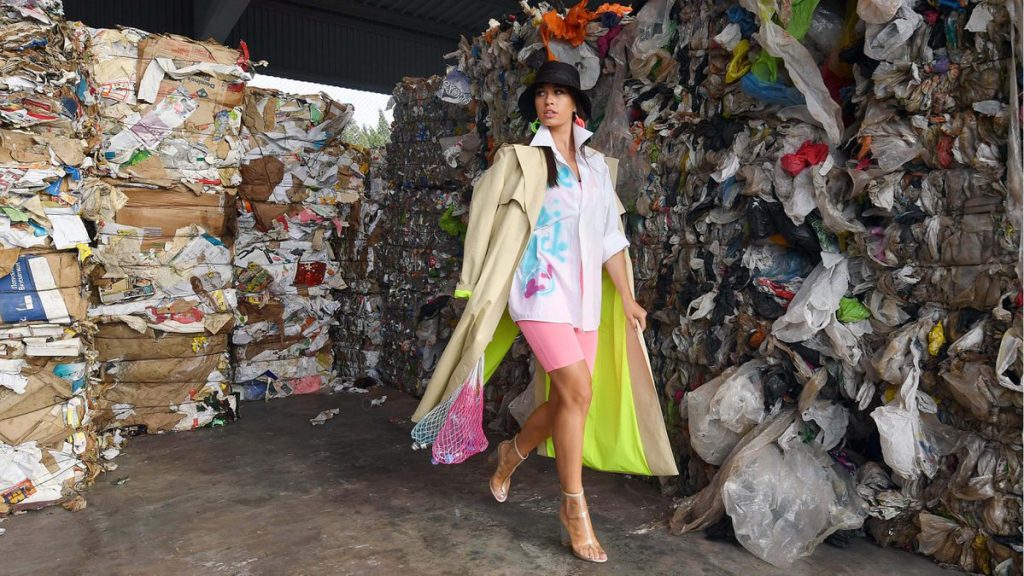Editor’s Note: FII’s #MoodOfTheMonth for July 2022 is Gender and Environment. We invite submissions on the many layers of this theme throughout the month. If you’d like to contribute, kindly refer to our submission guidelines and email your articles to sukanya@feminisminindia.com
Fast fashion is described as replicating recent fashion trends and designs, mass producing them at a low costs, and selling them in markets where the demand is high. Shopping for clothes was once considered to be a heavy chore where people saved up money to buy dresses for specific events, or only during a particular time of the year.
However, the idea soon began to change in the late 1990s, and shopping became entertainment, and the money spent on clothing drastically increased. Fast fashion soon entered the scenario, and people got to buy trendy garments for a low cost that allowed them the access to wear the same outfits as their favourite entertainers or famous personalities.
The world today, is hungry to consume fast fashion, and to keep up with the demands, fashion brands are over-stocking their products to satisfy their customers. “The global population has roughly doubled since 1970, but the growth of fashion has outpaced this growth several times over. With an annual consumption of about 80 billion new pieces of clothing around the world, a 400 per cent increase since 2000, we are not just outfitting the population. The effects of this insatiable appetite for fashion have extreme impacts on people and the environment,” reported Healthy Human.

Fast fashion has intersections with the environment and gender. It harms both the environment and the economy, and also promotes extreme consumerist behaviour. Producing clothes requires a lot of energy and resources, and the remains of these toxic fabric dyes contribute to environmental harm, and the chemicals contaminate fresh water.
According to Levi Strauss & Co., the production of jeans emits the same amount of carbon as driving a car for 80 miles would. Fashion and mass production have even more drastic impacts on polluting fresh water supplies. A pair of jeans would require 2,000 gallons of water and the textile wastes and dyes produce 20 per cent of the global wastewater. This wastewater is released directly into rivers and thus, increases the risk of contaminating the environment for both acquatic animals and other living organisms in the surrounding areas.
Fast fashion creates an unsafe space for women and forces them into a cycle of insecurities, body image issues, creates a drive for consumption of trendy clothes to fit into the narrative created for them by the society, and accelerates self-esteem related mental health issues. It promotes a very narrow and unreasonable ideal body type, which teaches young girls and women that they are not enough unless they dress and behave exactly the way they are expected to
On the other hand, fast fashion feeds on women’s insecurities and bodies. Women are agents of consumerism and their bodies have been discussed for years all over the world. A woman has to take care of how she looks, what she wears, and the movements her body makes, apart from constantly being judged for existing in a body that is largely objectified.
As feminist philosopher and author Simone de Beauvoir (1949) very famously said, “One is not born, but rather becomes, a woman.” Biology, physiology or psychology do not define a woman, but rather, women learn the roles of their life through male mandates and the patriarchal society.
The fast fashion industry takes advantage of this idea and feeds off women’s insecurities, and idealises the fantasies instilled by the patriarchal society into their minds. Fast fashion is also a gender issue because most of the employees in the fashion industry are women, comprising 80 per cent of the 75 million people who are currently making clothes. Fashion is slow on gender equality, but fast on polluting the environment.
Also read: Consumerism, Environmental Degradation, And Their Disproportionate Effects On Women

“Apparel isn’t walking the talk when it comes to gender equality,” explains Pauliina Murphy, Engagement Director at the World Benchmarking Alliance (WBA). “For decades, these companies’ clothes have dressed and inspired millions of women. But the same clothes are empowering some at the expense of others. We’re used to the term ‘fast fashion’ – after all, apparel moves quickly to make a profit and drive sales, but we see a marked difference between what companies say and do on vital issues such as pay, gender balance in leadership and violence and harassment. This lip service has to stop”, she adds.
Fashion can be sustainable. Fashion can be equal and fashion can still be affordable. The change will happen when fashion brands change their outlook on the industry, become transparent, and practice treating all employees equally. The potential for this change is also in our hands. By opting out of brands that cause harm to the environment and its workers, we reduce the power that they hold
Fast fashion creates an unsafe space for women and forces them into a cycle of insecurities, body image issues, creates a drive for consumption of trendy clothes to fit into the narrative created for them by the society, and accelerates self-esteem related mental health issues. It promotes a very narrow and unreasonable ideal body type, which teaches young girls and women that they are not enough unless they dress and behave exactly the way they are expected to.
The fast fashion industry relies solely upon discrimination and unequal opportunities to silence feminist concerns about gender inequality. When young women are highly represented in advertisements and posters for fast fashion, they are often influenced or pushed into jobs in the fashion industry. Age is another factor that is of significance here, because young women are more impressionable, and vulnerable to exploitation and injustice.
Women workers also face discrimination at the workplace. Workers in the fashion industry are grossly underpaid, and they sometimes don’t make enough money to even take care of their basic needs. They don’t receive a lot of leaves and are oftentimes even forced to sign a contract stating that they will not get pregnant during the work term. The working conditions are often very unpleasant and female employees complain or report experiencing sexual harassment at the workplace.
/GettyImages-1206779030-9450b9fda5694431a1056bf86aff0818.jpg)
“There is an absence of a minimum level of protective or preventative measures in the garment industry, like a standard policy for sexual harassment across the industry, or recognition and action against sexual harassment from senior levels of management. As a result, women workers reported they have little means to protect themselves or to receive appropriate support from factory management and duty bearers in the community,” reports Care, on the issue.
The fashion industry causes severe harm not only to the female workers but also to the environment. Some of the ways we can avoid falling into the trap of fast fashion are by talking to other people about fashion. By initiating conversations about sustainability and gender equality, we not only raise awareness, but also get to learn new things from other people.
It is also a great idea to support women-owned or run fashion brands. Even if the fashion industry comprises of several women and individuals from gender minorities, the decisive power positions are taken over by men. We must also hold brands accountable for the way they treat their female employees and refuse to buy products from them if they chose to not do the right thing.
Fashion can be sustainable. Fashion can be equal and fashion can still be affordable. The change will happen when fashion brands change their outlook on the industry, become transparent, and practice treating all employees equally. The potential for this change is also in our hands. By opting out of brands that cause harm to the environment and its workers, we reduce the power that they hold. Sustainability and slow fashion are the future. Let us make it our present.
Also read: Why Consumerist ‘Feminism’ Fails Us: Understanding Capitalist Culture
About the author(s)
Prathyusha [they/them] is a queer writer from Chennai. When they are not reading, they are either baking or buying books




